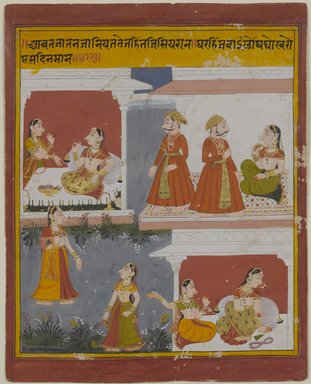
Medium: Opaque watercolor and gold on paper
Geograhical Locations:
Dates:early 18th century
Dimensions: with frame: 16 x 13 1/2 x 1/2 in. (40.6 x 34.3 x 1.3 cm) image: 9 13/16 x 7 11/16 in. (25 x 19.6 cm)
Collections:
Accession Number: 2010.48.19
Image: 2010.48.19_PS4.jpg,
Catalogue Description: Page from an illustrated manuscript of the Satasai (700 Verses), a romantic/devotional poem written in Braj Bhasa (a regional variant of Hindi) by Bihari in the early 17th century. The image is divided into four quadrants defined by architecture. In the upper left quarter, the romantic heroine -- dressed in a red blouse and golden skirt -- sits talking with her confidante (sakhi). In the upper right quarter, a standing man appears twice, once speaking with a seated woman -- not the heroine or her friend -- and once facing away from her. In the lower left quarter, two women speak with each other outside -- neither appears to be the sakhi -- and in the lower right quarter, the heroine appears again seated with her confidante, this time in a dejected posture with the sakhi gesturing as if making an important point. Scenes like that in the lower right are a common feature of the Satasai, in which the romantic heroine suffers terribly when she does not see her beloved and must be comforted by her friend. Often the heroine initiates the separation, which is her way of punishing her lover for infidelity. The confidante scolds and cajoles her, encouraging her to swallow her pride and end her suffering. The text at the top of the page is a verse from the Satasai. Its relationship to the image below is not immediately evident, because it deals with the cold reception a man receives at the home of his inlaws. However, traditional commentators on the verse have related it to a woman's inability to withhold her love from her husband, noting that she can bear the separation for about the same period that he can bear a visit to his in-laws. If we follow this interpretation of the verse, then we might see the lower right quadrant as an image of the suffering woman and the upper right quadrant as her mate, first speaking with his mother-in-law and then leaving. This page may be from a dated manuscript of the Satasai, made in Mewar in 1719. However, many pages associated with that manuscript are in a slightly different style. It is likely that the prolific atelier of Mewar produced many copies of the Satasai and that this is from a different series.